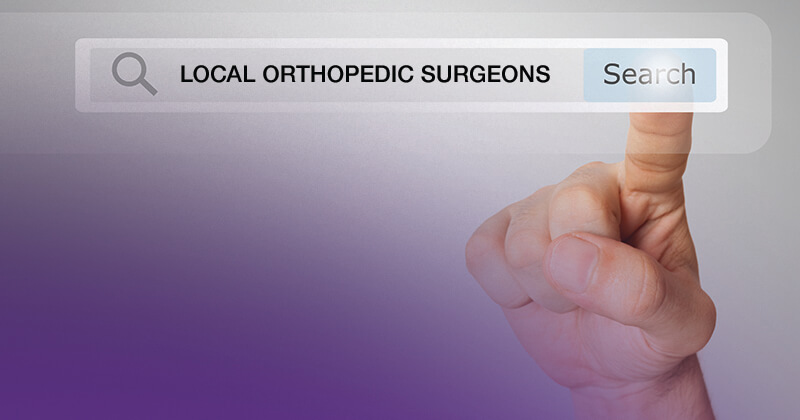How Can a Strong Online Presence Benefit Your Orthopedic Practice?

Here’s how an orthopedic blog and other digital tools can help your practice grow.
Digital media surrounds us on a daily basis—there’s virtually no escaping it between smartphones, smart speakers, wearable tech, smart car technology and beyond. It’s virtually everywhere, and for many of us, it plays a significant role in our daily lives. Gone are the days of having to pull encyclopedias off shelves and unfold printed maps from your car’s glove compartment. With 77 percent of Americans having a smartphone, we can simply ask our phone a question or browse the Internet for virtually anything we desire. We instantaneously have access to a wealth of resources in the palm of our hand.
Now, think about this in the context of running your orthopedic practice as a business.
- How do potential new patients find you?
- How do they track down the contact information for your practice?
- How do they decide to call your office for an appointment versus another orthopedic surgeon in the same community?
A strong online presence reveals the answer.
You can’t tackle all aspects of the World Wide Web, so I’ll highlight some key areas to focus on. Keep in mind that there is value in having a dedicated staff member on your team to handle such marketing efforts or employing the assistance of a skilled agency. A strong website with an orthopedic blog, accurate office location information, patient reviews and engaging social media set the foundation for a strong online presence. You need to “go” where your pool of potential patients looks for you, and that is online.
An updated website with an orthopedic blog
Your website serves as your prospective patients’ first digital impression of you and your orthopedic practice, so you want to make it a good one.
Did you know that 68 percent of consumers—your potential patients—start their research on the health industry via their mobile devices? That means there is even more reason to invest in your digital footprint.
With your website, make sure the information is current and updated regularly. I want to place particular emphasis on your contact information. One of the most frustrating issues is when you call a phone number for a business you find online and it doesn’t work or the address is off by a block. It can result in patients not even having the option of finding your practice to make an appointment.
You want to list your staff, along with photos and bios, treatment specialties, insurances accepted, office locations, contact information, and patient education, among other helpful content. The staff pages can showcase orthopedic expertise, awards, community involvement and even some personal information to better display your personality. Those skimming through your site will get a better “feel” for your practice and the people who make it up and will clearly know what area of orthopedics you specialize in.
Avoid the mistake of investing upfront in a great website, then letting it sit for months and months without any updates. It can do more harm than good. Cue the importance of an orthopedic blog. Blogs serve as a great resource and oftentimes become the spot on your website that updates most often. An orthopedic blog can help humanize your practice and your staff and can make potential patients feel as if they know you before they even walk in for an appointment.
So what should you write about? Orthopedic blog topics can range from an FAQ of top patient questions to staff profiles, industry trends and news, your involvement in the community and orthopedic space, treatment success stories, treatment options for common issues such as broken bones, athletic safety tips and stretches, and more. In my experience, humanizing a physician through a blog is generally refreshing to patients.
Another benefit of having a consistently updated orthopedic blog on your site is that it helps with search engine optimization (SEO). Essentially, when a patient searches for a topic, let’s say “treatment options for knee pain,” you ideally want your website and your blog articles to appear at the top of the search engine’s suggested options. This can help drive your potential patients to your website, while painting you and your practice as a top source on the topic they stumbled upon.
Blogs also lend themselves to become shareable content for social media, both for the reader and for you to use on your practice’s social media platforms and emails to patients.
Accurate orthopedic office location information
If you want both current and future patients to find you easily both online and in person, accurate location listings on Google My Business, Apple Maps and Bing Places are a must have.
62 percent of consumers who have selected a physician in the past three years are most concerned with location.
Thus, the importance of having your correct address, phone number, website URL, office hours and photos listed on maps can help your practice stand out when it comes to options in the area. If someone searches “orthopedic surgeons in South FL” and you’re located in that geographic area, you’d want your website and office location to appear as a top result, right?
The Value of Online Patient Reviews
Another facet of your online presence should focus on reviews patients leave online.
According to a Software Advice survey, 94 percent of patients who responded to its survey use online reviews to evaluate physicians.
Of course, your business listings are not the only place where online reviews can appear. However, reviews left on Google, for instance, will populate in search results and in your business location info so it’s in a prime spot and can help aid in SEO efforts as well.
With so many review sites out there for patients to leave feedback on, it becomes nearly impossible to manage and acquire reviews on all of them. Asking your current patient advocates to leave reviews on one or two key sites, let’s say Google and Healthgrades.com, can certainly help in attracting new patients and help your online presence as both a provider and a practice.
Creating signage at the check-in and checkout areas in your office, adding a link to the review site on your website, sending patients a postcard and soliciting for reviews via social media can help you leverage your patients who may be willing to share their experiences.
Another method to accumulate patient feedback is utilizing a patient survey tool that interfaces with your orthopedic practice management system. A tool like this can help you receive feedback after an appointment with automated surveys via text and email and consistently create new patient advocates.
Still skeptical of the value of reviews? A Software Advice survey uncovered that “a positive review history could bring out-of-network patients to your practice, as nearly half of respondents would go out of their insurance network for a provider with favorable reviews.”
Using the right tools and spending time to cultivate patient advocates can help in acquiring new patients to your practice.
An engaging and consistent social media presence
With 41 percent of patients reporting that social media would influence their choice of a specific doctor, hospital or medical facility, you’re missing a large population of individuals if you and your practice forgo a social media presence. This doesn’t mean that you have to claim a profile and post on every single network out there. I would actually advise against this. You want to tackle two to three platforms and ensure you can keep them updated on a consistent basis. Just like an outdated website, an outdated profile reflects poorly on your practice.
For starters, make sure you and your staff all have professional-looking LinkedIn profiles, and use the header area behind your profile photo for a branded background with your practice information. Your personal Facebook profile should remain just that—personal—so make sure you have strong privacy settings in place and know what information you have publicly facing.
In my opinion, Facebook and Instagram are the two more public spaces where you should consider a profile for your practice.
On Facebook, you can share the great blog article you drafted on treatment options for knee pain, for instance. Or, you can share photos from the local rec soccer team you’ve sponsored, client reviews that have been left online, staff Q&As, photos of your office and new technology that you are utilizing.
Social media is a very visual platform, so photos and videos tend to garner more engagement than long, drawn-out, text-heavy posts. One idea for a short video post could be showcasing the orthopedic electronic health record (EHR) system you use to demonstrate to patients how it can be used to help in the exam in explaining recommended treatment or surgical procedures.
Just remember that you need to abide by patient privacy rules in this digital space. Also, you should keep personal opinions on controversial topics out of the picture. The American Medical Association provides a great resource on social media professionalism, which I encourage you to review and share with staff, too.
Final Thoughts on Your Orthopedic Practice’s Digital Presence
When it comes to marketing your practice, the digital space has become more important than ever before to reach your audience of potential patients. There are numerous marketing tactics you can invest in, and you’ll have to evaluate the resources you have and the return on investment to know what tactics work best for your orthopedic practice.
There’s substantial value in garnering quality patient reviews and creating advocates out of your current patient base to help increase the volume of new patients in your practice. To help foster positive online reviews and word of mouth, you and your orthopedic practice staff need to provide a quality experience for the patient from the moment they walk in, to the time they check out.
Part of providing a positive patient experience involves using the latest orthopedic technology that can help foster patient engagement and provides a seamless experience. An iPad orthopedic electronic health record (EHR) system, orthopedic practice management software and patient engagement tools such patient reminders all factor into the equation of a positive patient experience.





